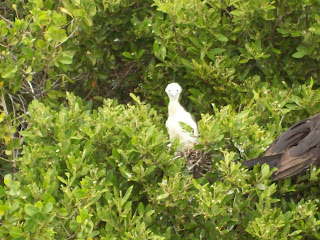At about 10 the next morning (Monday, March 8), we went in to shore where a charming fellow named Dilly was waiting for us with his taxi van. I was interested in Barbuda for a number of reasons.
The island was first settled by the Codringtons, who leased it from Britain in 1685 for the monstrous price of "one fat sheep". Codrington used the island to grow livestock and root crops for his sugar plantations on Antigua, and as a hunting ground. Wild pigs were introduced. The island was later abandoned to the slaves who had been imported by Codrington to work it. There was some subsistence farming as well as fishing and hunting. In the early days, donkeys were used as transport. When automobiles put in an appearance, the donkeys were allowed to run wild. As a result, the island is alive with wild pigs, the inevitable goats, wild donkeys and horses. The goats and pigs are hunted; the donkeys just hang out. The horses have owners and are carefully tended. They are not used as transport. Every second Sunday, there are horse races at a track south of the main village of Codrington. Alas, we were never there on an appropriate Sunday.
The total population of the island is about 1,500 souls. There is no individual land ownership. You fence in a bit of land, build a house and that's yours. The island is also essentially flat. The Highlands, on the Atlantic side, rise a staggering 125 feet above sea level. That's as high as it gets, folks.
In his Cruising Guide to the Leeward Islands, Chris Doyle says:
"...there have been several ambitious projects to develop the island...an idea strongly resisted by many Barbudans, who see no benefit to changing their traditional lifestyle for one of being dressed up and employed to wait on tourists, in exchange for the dubious benefits of better roads, more cars and Kentucky Fried Chicken."
The people of Barbuda halted a planned desalinisation plant, fearing that their beautiful lagoon would be destroyed. That lagoon was another reason I wanted to visit Barbuda.
The entire northwest of the island is a vast lagoon. I believe it is over 6 miles long and a mile or two wide. It is delimited by a narrow sand beach on the seaward side that runs 12 miles along the coast. The village of Codrington is on its landward, eastern edge. The lagoon is home to one of the largest frigate bird colonies in the world; matching those in the Galapagos. (I can't find any numbers, but we saw hundreds of birds during our visit.)
Dilly took us to a small dock in Codrington, on the lagoon, where George welcomed us aboard his skiff. We were joined by another group and he took his loaded boat into the lagoon.
Our first stop was a large buoy that had appeared offshore some time before. A couple of local fishermen had claimed it as salvage (they were after the tiny solar panel) and dragged it into the lagoon. There it rests, aground. Since most visitors to Barbuda are cruisers, George likes to show this example of the many dangers lurking out to sea and reminds us that a good lookout is worth all the GPS you can carry.
For a long time, no one knew where this buoy had drifted from, until an industrious American visitor used the Web and its buoy number to trace its history. It originally marked Grampus Rock, somewhere on Canada's east shore. It set off, one day, and wandered over to Spain. It probably cruised down the African coast for a bit before deciding to head for the Caribbean. It is now a permanent resident of Barbuda. Its bell rang gently as we moved off.
We then crossed the lagoon and viewed a sad little stand of mangrove. This was the original frigate bird colony, destroyed by a hurricane some years ago. Fortunately, the birds like the neighbourhood, so they just moved north a bit. Their noisy (rather smelly) nesting site was to be our last stop.
The magnificent frigate bird (to give its full name) or man-o'-war bird is so named because of its penchant for harassing other seabirds until they drop or even regurgitate the fish they have caught. I've seen them do this to terns. The frigate bird then swoops down and takes the meal. They also catch surface fish...they are not divers, nor are they swimmers. They spend literally weeks in the air and travel hundreds of miles, riding the air currents in glorious swoops and glides. At the colony, I saw them preen on the wing, ruffle and settle their feathers on the wing...activities most birds perch for. They are big birds, with a wingspan of some 2.5 metres. When they do come in for a landing, it is usually at a nesting colony such as the one on Barbuda.
The males have a dark red pouch at the throat which they inflate as part of the mating ritual. It was not breeding season (there were chicks about) when we were there, but there were inflated pouches...perhaps just claiming a branch or a bit of territory. The colony features all ages and stages of frigate bird. A marvel.
We had a fabulous ogle while George explained the steps Barbuda has taken to ensure the birds are not disturbed. He also introduced us to the "upside down jellyfish" that are found in the area.
Then we were taken back to Codrington for lunch and the remainder of our tour with Dilly.
Tuesday, April 6, 2010
Subscribe to:
Post Comments (Atom)





No comments:
Post a Comment